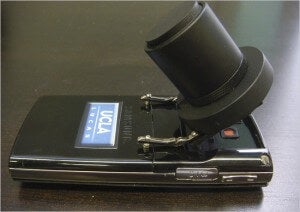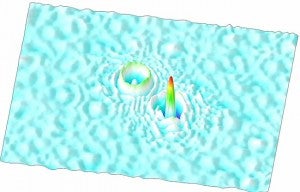
In the field of global medicine, laboratories are a precious commodity. Yet even if a remote village doesn’t have access to a local lab or even a doctor, they may be able to get reliable test results…through a mobile phone. Professor Aydogan Ozcan at UCLA has been developing a series of attachments for phones that will act as microscopes, but without lenses. Using hardware that costs less than $10, these mobile microscopes will be able to use the shadows of cells to detect illnesses. Ozcan, through his new company Microskia, is trying to bring these attachments to market and connect them, via the mobile phone, to a database which will then text the phone with results in just five minutes! Doctors, or maybe anyone with a phone in the field, could use the system to make quick, cheap, and accurate assessments of diseases. Check out the video from UCLA after the break.
Most of the emerging cases of HIV are in India and Africa, where access to central labs is infrequent. Checking blood samples in even the most routine cases can take days. Likewise with Malaria, still one of the biggest killers and most feared infectious diseases in the world. Different versions of Ozcan’s mobile phone attachments could help diagnose patients with these diseases in just minutes, providing better opportunities for care. As this technology develops, private use could expand as well. Imagine being able to take a daily blood sample at home and test it daily for pathogens. You could know you were sick before you ever had symptoms. There are other dangerous microscopic particles besides pathogens. Mobile phone microscopy could help researchers find asbestos, lead, or other environmental poisons quickly. With this level of quick analysis, healthcare and longevity would improve dramatically.
Another team at UC Berkeley has developed a similar product called the cellscope. Ozcan’s device however, uses no lenses, and doesn’t take traditional images of cells. Magnification is done digitally, not optically.The system is called LUCAS or Lensless Ultra-wide-field Cell monitoring Array platform based on Shadow imaging. A mouthful to say, an impressive concept to see in action. Using relatively cheap light emitting diodes, LUCAS is able to form a sort of shadow holography, creating detailed images derived from the transparency of cells. That cell shadow contains a lot of information about the health of the cell.

When LUCAS is used on a sample, healthy and infected cells are shown side by side. In this way, the analysis is more holistic than traditional light microscopy and could assist researchers in forming the database used to recognize illnesses. That database is very important because LUCAS does not produce traditional images. Untrained medical professionals, and even experienced lab technicians, would not necessarily be able to translate the LUCAS images into a diagnosis on their own.
The cell shadow database, and the LUCAS hardware is still under development. As shown in the UCLA video, there will likely be many different forms of the mobile phone attachments, not just to fit with the various phone models, but also to provide different kinds of imaging in the field. There are versions with USB connections for phones without cameras and at least one version with different color LEDs to help with specific disease recognition.
Ozcan’s system is promising, amazingly so. And while I’m excited about possibilities in global healthcare it may one day provide, I am uncertain how long it will take to realize his goals. The LUCAS database will have to be assembled very thoroughly and designed to handle an impressive amount of traffic in order to serve as a world wide diagnostic tool. Even if confined to more traditional forms of microscopy (like that used by Cellscope), mobile diagnosis would still require an extensive technical support system. Still, Ozcan has a few things going for him: his own dedicated brilliance, and the rise of highly sophisticated narrow artificial intelligence. We may one day see mobile diagnostic tools contacting not a doctor, but an AI that can analyze blood samples in microseconds. Oh the possibilities. We’ll let you know if any of it actually happens.
Photo credits: Ozcan via NY Times
Video credit: UCLA


